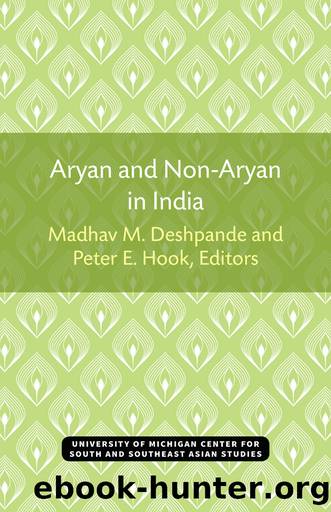Aryan and Non-Aryan in India by Madhav M. Deshpande & Peter Edwin Hook

Author:Madhav M. Deshpande & Peter Edwin Hook
Language: eng
Format: epub
Publisher: University of Michigan Center for South and Southeast Asian Studies
FIGURE 1 Tamil and Hindi Kinship Terms for Motherâs Brother, Fatherâs Sisterâs Husband, and Spouseâs Father
The radical differences which distinguish the two kinship systems constitute an inherent obstacle to their complete convergence; a synthetic system cannot be created without altering the fundamental principles of one or both systems. Convergence between Dravidian and Indo-Aryan terminologies can be studied empirically, for their geographical distributions overlap, forming a broad frontier zone where castes of each kinship system live in close proximity, sometimes in the same village. In such settings we generally find a shared lexicon of kinship marking a divergent semantics which can easily be identified as either Dravidian or Indo-Aryan for any given case.
Kathiawar falls within the frontier zone, and analysis of Trivediâs data on the terminologies of the Mer and of Gujarati (unspecified as to caste) of that area may be used in illustration of those effects.11 Terms for kinsmen in the parentsâ generation are given in figure 2.
The vocabulary is identical, but the Mer employ only four of the ten Gujarati terms. This is because the semantic categories of the Mer are organized by a Dravidian logic which takes systematic cross-cousin marriage as its basis, and, in consequence, their terminology is fundamentally the same as that of the Tamils, in spite of its non-Dravidian lexicon. The groupings of genealogical referents in the Mer terminology may be derived directly from the genealogical representation of Tamil terminology in figure 1, producing the equations MB=FZH=SpF (mÄmÄ) and FZ=MBW=SpM (fuÄ«). The remaining two groups, FB=MZH and MZ=FBW, Mer kÄkÄ and mÄsÄ« respectively, are also found in Tamil which, however, additionally includes father and mother in these two categories while the Mer have distinct terms for them (bÄpu, mÄá¹ ). The ten Gujarati terms, plus the two terms for father and mother (bÄpu, man) not given in figure 2, by contrast, are structured both lexically and semantically in a manner fundamentally the same as among other Indo-Aryan systems. In other regions of the semantic field defined by Mer kinship terms the story is very much the same: in semantic structure the system is recognizably Dravidian, and although the influence of environing Indo-Aryan systems is by no means negligible, these influences are largely confined to such surface features as the lexicon.
Download
This site does not store any files on its server. We only index and link to content provided by other sites. Please contact the content providers to delete copyright contents if any and email us, we'll remove relevant links or contents immediately.
| Africa | Americas |
| Arctic & Antarctica | Asia |
| Australia & Oceania | Europe |
| Middle East | Russia |
| United States | World |
| Ancient Civilizations | Military |
| Historical Study & Educational Resources |
The Story of China by Michael Wood(932)
Mr. Selden's Map of China by Timothy Brook(776)
Philippines--Culture Smart! by Culture Smart!(669)
Heroic Hindu Resistance To Muslim Invaders (636 AD to 1206 AD) by Sita Ram Goel(658)
Akbar: The Great Mughal by Ira Mukhoty(653)
The Meaning of India by Raja Rao(632)
Vedic Physics: Scientific Origin of Hinduism by Raja Ram Mohan Roy(630)
Food of India by unknow(618)
Banaras by Diana L. Eck(617)
India--Culture Smart! by Becky Stephen(605)
China Unbound by Joanna Chiu(605)
First Platoon by Annie Jacobsen(602)
Mao's Great Famine: The History of China's Most Devastating Catastrophe, 1958-1962 by Frank Dikötter(596)
North of South by Shiva Naipaul(591)
Insurgency and Counterinsurgency by Jeremy Black(568)
A History of Japan by R.H.P. Mason & J.G. Caiger(566)
How to Be a Modern Samurai by Antony Cummins(565)
The Genius of China: 3,000 Years of Science, Discovery, and Invention by Robert Temple(565)
The Digital Silk Road by Jonathan E. Hillman(552)
